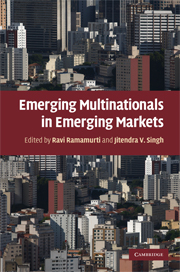Book contents
- Frontmatter
- Contents
- List of figures
- List of tables
- List of abbreviations
- List of contributors
- Acknowledgments
- Part I Introduction
- Part II Country Studies
- 5 Chinese multinationals: Emerging through new global gateways
- 6 Indian multinationals: Generic internationalization strategies
- 7 Russian multinationals: Natural resource champions
- 8 Brazilian multinationals: Surfing the waves of internationalization
- 9 South African multinationals: Building on a unique legacy
- 10 Mexican multinationals: Insights from CEMEX
- 11 Thai multinationals: Entering the big league
- 12 Israeli multinationals: Competing from a small open economy
- Part III Conclusions
- Index
- References
8 - Brazilian multinationals: Surfing the waves of internationalization
from Part II - Country Studies
Published online by Cambridge University Press: 03 July 2009
- Frontmatter
- Contents
- List of figures
- List of tables
- List of abbreviations
- List of contributors
- Acknowledgments
- Part I Introduction
- Part II Country Studies
- 5 Chinese multinationals: Emerging through new global gateways
- 6 Indian multinationals: Generic internationalization strategies
- 7 Russian multinationals: Natural resource champions
- 8 Brazilian multinationals: Surfing the waves of internationalization
- 9 South African multinationals: Building on a unique legacy
- 10 Mexican multinationals: Insights from CEMEX
- 11 Thai multinationals: Entering the big league
- 12 Israeli multinationals: Competing from a small open economy
- Part III Conclusions
- Index
- References
Summary
Recent years have seen a flourishing of interest in the economies of the BRICs and their growing role as producers and intermediate rank powers in the global economy (Goldman Sachs, 2003; Humphrey and Messner, 2006). Although often taken as a single group, they have taken different paths, with China and India on the one hand and Brazil, Russia, and South Africa on the other.
The objective of this chapter is to analyze the emerging Brazilian multinationals, with special reference to how the national context affected the evolution of those firms. Two distinct approaches will be combined to achieve that aim. The first provides historical perspective; the second defines the conceptual framework that will be utilized in the analysis of selected cases.
After WWII, Brazil performed differently in relation to the three main waves of internationalization. In the first wave, in the 1950s and 1960s, Brazil was essentially a receiver of FDI, hosting new subsidiaries of foreign MNEs. During the second wave, in the late 1970s and early 1980s, isolated attempts by native Brazilian firms to move into international markets were observed. “The so-called Third World Multinationals (non-financial) in Brazil,” it was noted, “are still at a rather incipient stage where the number of firms is concerned and as a percentage of the total value of exports … construction and engineering firms predominate. Manufacturing firms are moving at a much slower pace, though one group has recently announced ambitious plans” (Villela, 1983, p. 267).
- Type
- Chapter
- Information
- Emerging Multinationals in Emerging Markets , pp. 200 - 243Publisher: Cambridge University PressPrint publication year: 2009

